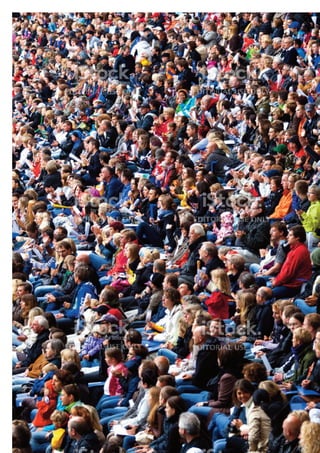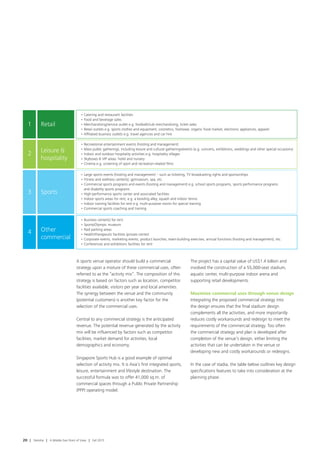POV 18 - Mixin' it up (1)
- 2. Deloitte | A Middle East Point of View | Fall 2015 | 19 MixinŌĆÖ it upCommercialization opportunities in GCC sports venues Sports venue operators have become increasingly creative in their efforts to identify additional revenue streams by capitalizing on the needs of the local community and market. In this article we explore which opportunities are available in the Middle East region and steps to introduce these complementary activities as part of the sports venueŌĆÖs value proposition. The Gulf Cooperation Council (GCC) region has the opportunity to develop broader attractive and sustainable commercial offers at sport venues. Traditionally the regional sports venues operators (e.g. sports clubs and sport governing bodies) have focused their efforts on traditional sporting events. The region has recently started to explore other commercial opportunities not related to sporting events such as business and cultural events, restaurants facilities, rental of commercial spaces and other retail opportunities. Operators are facing significant challenges to exploit these new commercial opportunities. The common challenges include operational and logistical complexities, lack of suitably qualified and experienced professionals and incompatibility of traditional European approaches to supplemental revenue generation with local factors such as climatic conditions and cultural norms. Early selection and planning of the commercial uses are key to address some of these challenges. Commercial uses available and selection The commercial uses available can be classified into four categories: retail, leisure and hospitality, sports and other commercial. Table 1 lists a selection of the typical commercial uses for sports venues for each category. Sports
- 3. Retail1 2 3 4 ŌĆó Catering and restaurant facilities ŌĆó Food and beverage sales ŌĆó Merchandising/service outlet e.g. football/club merchandizing, ticket sales ŌĆó Retail outlets e.g. sports clothes and equipment, cosmetics, footwear, organic food market, electronic appliances, apparel ŌĆó Af’¼üliated business outlets e.g. travel agencies and car hire ŌĆó Recreational entertainment events (hosting and management) ŌĆó Mass public gatherings, including leisure and cultural gatherings/events (e.g. concerts, exhibitions, weddings and other special occasions) ŌĆó Indoor and outdoor hospitality activities e.g. hospitality villages ŌĆó Skyboxes & VIP areas, hotel and nursery ŌĆó Cinema e.g. screening of sport and recreation-related ’¼ülms ŌĆó Large sports events (hosting and management) ŌĆō such as ticketing, TV broadcasting rights and sponsorships ŌĆó Fitness and wellness center(s); gymnasium, spa, etc. ŌĆó Commercial sports programs and events (hosting and management) e.g. school sports programs, sports performance programs and disability sports programs ŌĆó High-performance sports center and associated facilities ŌĆó Indoor sports areas for rent, e.g. a bowling alley, squash and indoor tennis ŌĆó Indoor training facilities for rent e.g. multi-purpose rooms for special training ŌĆó Commercial sports coaching and training ŌĆó Business center(s) for rent ŌĆó Sports/Olympic museum ŌĆó Paid parking areas ŌĆó Health/therapeutic facilities (private center) ŌĆó Corporate events, marketing events, product launches, team-building exercises, annual functions (hosting and management), etc. ŌĆó Conferences and exhibitions facilities for rent Leisure & hospitality Sports Other commercial 20 | Deloitte | A Middle East Point of View | Fall 2015 A sports venue operator should build a commercial strategy upon a mixture of these commercial uses, often referred to as the ŌĆ£activity mixŌĆØ. The composition of this strategy is based on factors such as location, competitor facilities available, visitors per year and local amenities. The synergy between the venue and the community (potential customers) is another key factor for the selection of the commercial uses. Central to any commercial strategy is the anticipated revenue. The potential revenue generated by the activity mix will be influenced by factors such as competitor facilities, market demand for activities, local demographics and economy. Singapore Sports Hub is a good example of optimal selection of activity mix. It is Asia's first integrated sports, leisure, entertainment and lifestyle destination. The successful formula was to offer 41,000 sq.m. of commercial spaces through a Public Private Partnership (PPP) operating model. The project has a capital value of US$1.4 billion and involved the construction of a 55,000-seat stadium, aquatic center, multi-purpose indoor arena and supporting retail developments. Maximize commercial uses through venue design Integrating the proposed commercial strategy into the design ensures that the final stadium design complements all the activities, and more importantly reduces costly workarounds and redesign to meet the requirements of the commercial strategy. Too often the commercial strategy and plan is developed after completion of the venueŌĆÖs design, either limiting the activities that can be undertaken in the venue or developing new and costly workarounds or redesigns. In the case of stadia, the table below outlines key design specifications features to take into consideration at the planning phase.
- 4. Feature 6,000 capacity stadium 10,000 capacity stadium 20,000 capacity stadium 30,000 capacity stadium Roof To cover at least 2,000 spectators To cover at least 3,400 spectators To cover at least 6,700 spectators To cover at least 10,000 spectators Parking ŌĆō car VIPs ŌĆō 150 spaces Sponsors ŌĆō 100 spaces Hospitality ŌĆō 75 spaces Spectators ŌĆō 950 spaces TOTAL ŌĆō 1,275 spaces Gross space 31,875 m┬▓ VIPs ŌĆō 150 spaces Sponsors ŌĆō 100 spaces Hospitality ŌĆō 125 spaces Spectators ŌĆō 1,585 spaces TOTAL ŌĆō 1,960 spaces Gross space 49,000 m┬▓ VIPs ŌĆō 150 spaces Sponsors ŌĆō 100 spaces Hospitality ŌĆō 375 spaces Spectators ŌĆō 3,170 spaces TOTAL ŌĆō 3,670 spaces Gross space 91,750 m┬▓ VIPs ŌĆō 150 spaces Sponsors ŌĆō 100 spaces Hospitality ŌĆō 560 spaces Spectators ŌĆō 4,750 spaces TOTAL ŌĆō 5,375 spaces Gross space 134,375 m┬▓ Hospitality Backrest ŌĆō minimum 300mm Tread depth ŌĆō minimum 1,000mm Seat width ŌĆō recommended minimum 600mm Volume ŌĆō minimum 300 seats Private area ŌĆō minimum net space of 600m┬▓ Backrest ŌĆō minimum 300mm Tread depth ŌĆō minimum 1,000mm Seat width ŌĆō recommended minimum 600mm Volume ŌĆō minimum 500 seats Private area ŌĆō minimum net space of 1,000m┬▓ Backrest ŌĆō minimum 300mm Tread depth ŌĆō minimum 1,000mm Seat width ŌĆō recommended minimum 600mm Volume ŌĆō minimum 1,000 seats Private area ŌĆō minimum net space of 2,000m┬▓ Backrest ŌĆō minimum 300mm Tread depth ŌĆō minimum 1,000mm Seat width ŌĆō recommended minimum 600mm Volume ŌĆō minimum 1,500 seats Private area ŌĆō minimum net space of 3,000m┬▓ Public refreshment facilities ŌĆō permanent 24 points of sale 3-4 concessions 180m┬▓ - 240m┬▓ of dedicated space 40 points of sale 5-7 concessions 300m┬▓ - 420m┬▓ of dedicated space 80 points of sale 10-14 concessions 600m┬▓ - 840m┬▓ of dedicated space 120 points of sale 15-20 concessions 900 m┬▓ - 1,200 m┬▓ of dedicated space Deloitte | A Middle East Point of View | Fall 2015 | 21 Four steps to success During the planning phase, a commercial and operational plan will define the potential activity mix of the sport venue, capture specific design requirements and assist the design team to integrate these into the venue design. The following approach is recommended to develop commercial and operational plans: 1. Market analysis and commercialization elements selection: assess the level of market demand for a range of commercial activities and develop a schedule of commercial, leisure, sports and retail uses to stimulate the area socially and commercially 2. Financial analysis (feasibility assessment): undertake a financial appraisal of the proposed activity mixes, developing and reporting on key performance metrics to assess viability 3. Stakeholder consultations and operating model selection: hold consultations to assess the viability of the developing concept and establish the appropriate operating structure 4. Commercial and operational plan development: develop a detailed description of the proposed activities mix, how this will be implemented and any specific design requirements for inclusion into the venue design by Joaquin Martinez, Senior Manager, Consulting, Deloitte Middle East Sports 1. Market analysis and commercialization elements selection 2. Financial analysis (feasibility assessment) 3. Stakeholders consultations and operating model selection 4. Commercial and operational plan development




